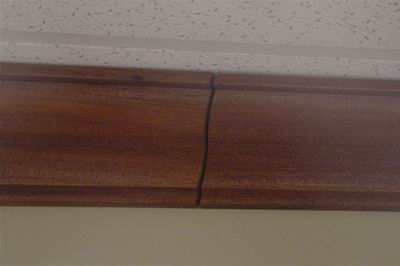Question (WOODWEB Member) :
We've specified a Pemko residential interlocking threshold for a project consisting of a J-hook (61) and a threshold (121). The J-hook began to come undone within six months of installation, causing the door seal to fail. To speculate the problem, the reason seems to be that the hook is nailed into the bottom of a door that is made in three pieces - a horizontal member in the middle, and two vertical members on the ends. The nails are being hammered into end-grain at the two ends of the door (the vertical members) which is why they are coming out. Is this problem common? I can't find any specific instructions for installation, so I was wondering if anyone had any tips for installation.
Weather-Stripping for Exterior Doors
Forum Responses
(Architectural Woodworking Forum)
From contributor r:
There is very little room for slop with an interlock threshold. It should not bind at all and should not bottom out without backing from the rabbet cut or you will essentially pull it off the bottom of the door. Nailing into the end grain is not ideal but I am guessing something is out of alignment and causing your problems. What type of weatherstripping is used on the jamb? On new construction we always have issues with re-adjusting doors after the house has settled, and they do settle. Are the reveals/margins still good?
When the epoxy has set and the door is completely fit and hardwared, it is ready for the hook. Nail the j-hook every 1-1/2" at end grain with the brass nails supplied with the hook. Use a fine nail set to punch the brass, or even pre-drill it if you wish. Locate nails in about 1/4" from the 'outside' edge of the brass hook to give it plenty of room to 'spring'. Nail about every 2-1/2" to 3" into the edge of the rail. Do not use your 32 oz. waffle-head here. Finesse counts.
Close and latch the door and push the sill part firmly back into the depth of the j-hook and mark the sill where it sits. You may have to get your putty knife out and spring the hook down some so the bronze part will sit down flat onto the wood sill, allowing an accurate mark to be made. Open the door, pre-drill the screw holes for the sill part. Examine your heavy bronze sill and take a bit of time to carefully bend a bow into it so it will contact the wood firmly when screwed down. Watch out at the screw holes, because it is easy to kink it at those points. Work slowly and carefully, this is expensive stuff. Then put a small bead of clear silicone along each leg of the sill part, the full length, and fasten in place.
Resist the very strong urge to close the door. Use a putty knife with a 2" wide blade to spring the j-hook down a bit until it will contact the upper side of the bronze sill as you start to close the door. Start at the hinge side and work it bit by bit until it contacts the entire way. Over bend the bronze somewhat so it contacts the top of the bronze, not the bottom. If you are doing it right, the nail heads will be 1/8" plus above the bronze sill. By springing the hook down, you give yourself the needed clearance and the bronze repels water best if it contacts the top edge and then around and down the J shape.
In exposed doors that still will leak blowing water, it may be necessary to get some of the 1/8" silicone tube weatherseal (Resource Conservation?) and lay a small bead of silicone into the deepest part of the hook and then lay in the silicone tube. It is hollow and will smash to almost nothing when the door closes, sealing out the water. Most leaks I have seen are caused by the bronze sill bowing up between the screws and no silicone between the bronze sill and the wood sill. If it is not the rug that pulls the nails out, then it is the nails rubbing on the bronze and wearing off, letting the hook flop around. The door has to be refit to get more clearance. I have heard for over 40 years that the door "sits down" on the hinges, or the "frame settles" or the door sags (?), or any of a hundred more excuses for the j-hook rubbing or being destroyed. The fact is that if the door is hung right, and the frame is secured properly, the door will clear that sill for 50 years or more, as long as there are no earthquakes or.
As far as settling goes, it's not the whole house that settles so much as the framing - which shrinks and throws doors out of wack. In new construction, on wood floors, I've had problems with interlock, but if the doors are adjusted after the house settles, and sometimes that means cutting the bottom again and fitting a new j-hook, Contributor O is totally right. Interlock thresholds last a very long time.
